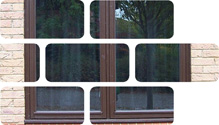
Timber Windows Wood 17 02 01
Timber windows are made in various sizes, types and arrangements depending on the specification required. They are of varying quality, from softwood small profile windows to more desired hardwood windows or specialist display windows. Most windows are mass produced, whereas some are made-to-measure to suit a particular architectural finish. All windows will incorporate glass or glazed units and a range of fixtures.
Usage & Probable Locations
Timber windows allow natural daylight and fresh air into buildings. They may have a casement, hopper, slider or sash in the frame to allow opening, or will be simply a fixed window. Most timber windows are fitted into external walls, but some will be fitted internally to help spread the right mix of light into the building. Some are fitted into roofs or may be arranged to form an atrium.
Personal Protective Equipment
PPE requirements indicated are for guidance purposes only. DRIDS has identified the PPE that is mandatory on all demolition projects and ones that may be required subject to site specific Risk Assessment & Method Statement (RAMS). Hover over the icon to determine the types of PPE required for the removal of this material.
Removal, Segregation & Storage
Depending on how timber windows have been fitted for use, will determine how they are removed, segregated and stored. Timber windows in good condition, of architectural or ornamental value and uncontaminated will have a reuse value, especially if there is a large number of similar size. They should be segregated and stored inside on skids, pallets or vertically away from the wind to prevent toppling and covered with plastic or tarpaulin to keep dry. They should also be stored away from plant movements to prevent breakage or splash damage. Timber windows destined for recycling or recovery should be segregated from other materials in a timber only skip. Timber windows destined for landfill can be placed in the mixed waste skip.
Tools
Fixtures, Fittings & Connections
Timber windows are commonly built into cavity walls or timber frame panel systems and fixed in place with nails, wedges, screws, cavity fasteners, mortar or mastic. Window casements, sashes, hoppers and sliders will be fastened in place with a casement handle and/or a casement stay and secured with a sash bolt, window lock, cylinder lock, window bolt or other type of window lock. They may include handles to open, slide or lift the window opening. Most windows will incorporate plastic or metal window vents. All windows will be coated, painted or preserved in one form or another.
Health & Safety
Subject to task-specific Risk Assessment & Method Statement (RAMS). Use correct protective equipment for removing fixings, especially bolts, nails and screws. Wear gloves when handling timber windows with damaged edges or coated in preservatives to prevent irritation, cuts and splinters. Wear eye protection when removing nails with a crowbar, hammer or nailbar and at all times when using chisels. Use specialist gloves, face protection and clothing if removing glass. Beware of large window openings to prevent falls from height.










